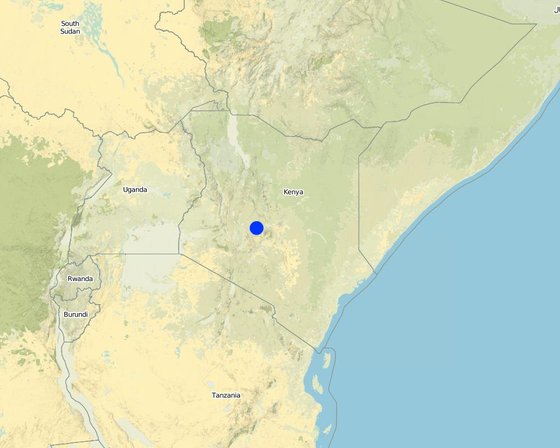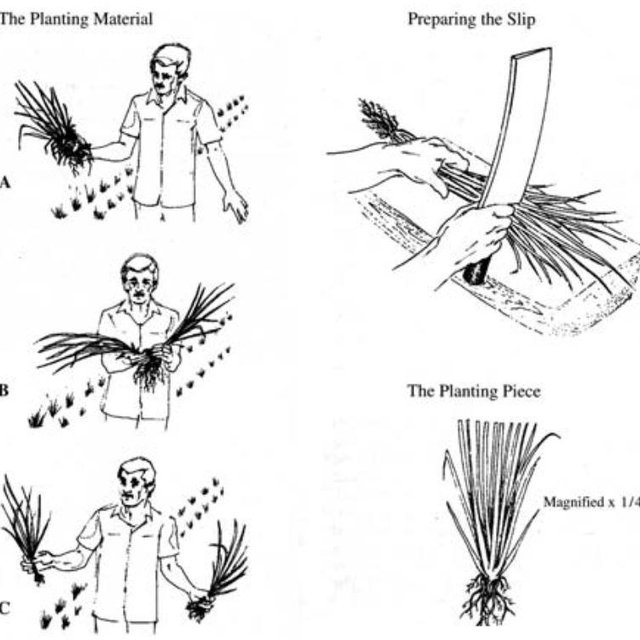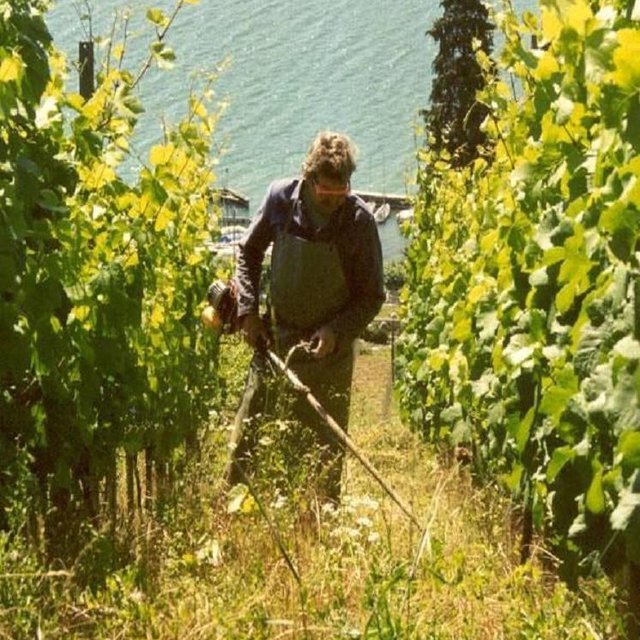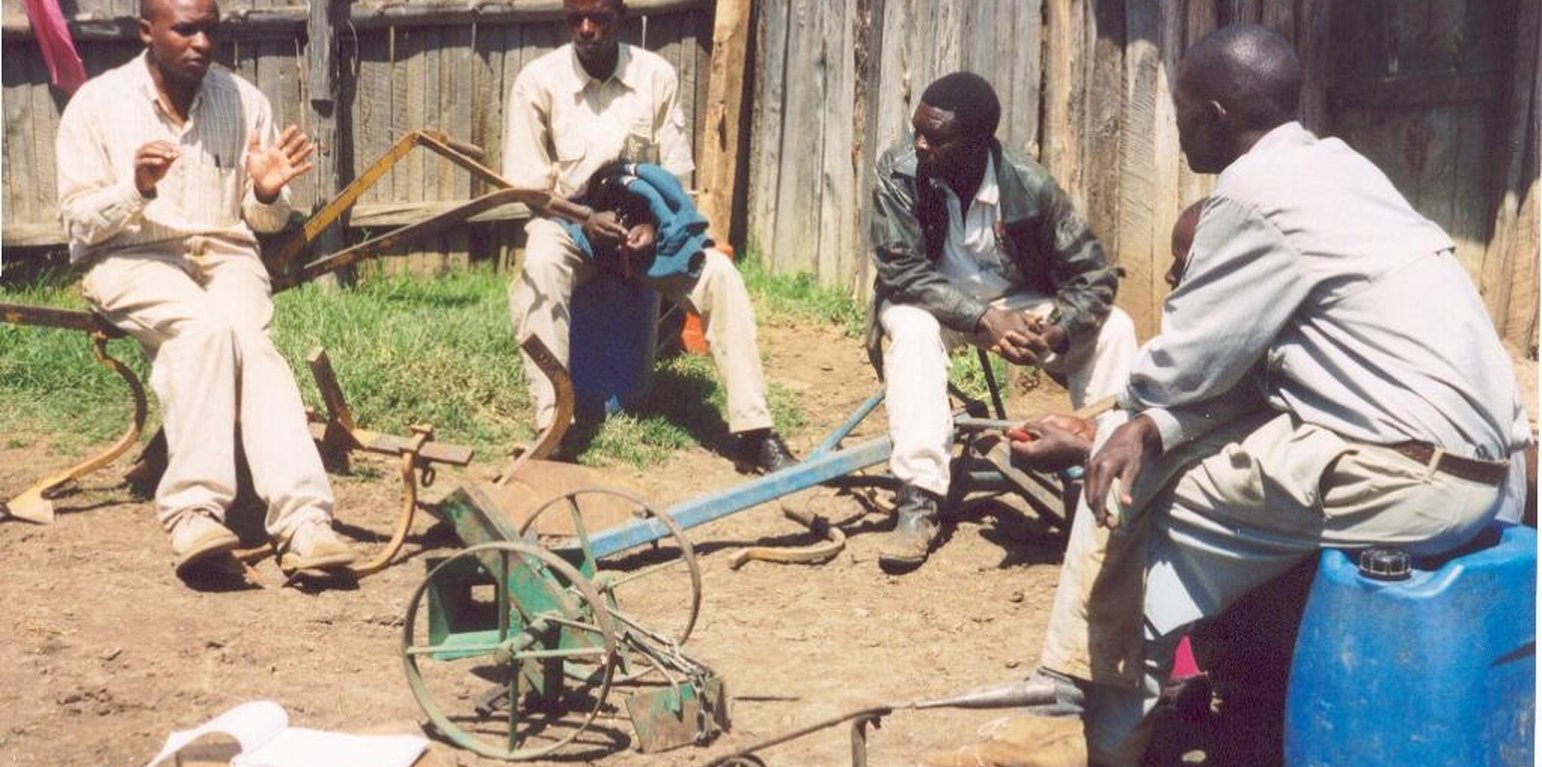Self-help groups
(Kenya)
Description
Small-scale farmers forming self-help groups to provide mutual support for adopting and promoting conservation agriculture.
Aims / objectives: The self-help group approach described here is an initiative which grew from the local land users themselves. Farmers with common interests and goals came together, formed and registered groups and developed constitutions. Conservation agriculture groups started forming in 1997: within two years, five groups had been set up in the study area with over 150 members. The Ministry of Social Services facilitated the registration process. Groups have liased with technology promoters from the Ministry of Agriculture, KENDAT (Kenya Network for Draught Animal Technology), and research and development projects, to gain access to technical knowledge. These organisations have set up research and monitoring projects to assess the impact of conservation agriculture in this area. The groups receive more attention from local development partners than individuals would. The overall purpose behind the formation of the groups is to improve household food security and raise income. More specific objectives include: (1) mutual adoption of the technology, enabling group members to improve their farm operations and yields, and thereby; (2) creation of opportunities for additional income to help and support each other; (3) sharing knowledge, and conservation tillage equipment.
Role of stakeholders: Groups involve themselves in farmer-to-farmer training. They develop training modules which cover all aspects of conservation agriculture as well as practical training of the animals. Meetings are held once a month to plan group activities. The groups also solicit loans from local development partners for equipment, and they access training on technology from national institutions. Further collaboration with national institutes is planned to facilitate availability of droughttolerant crop varieties. The members of the self-help groups make various contributions including time, money, animals and some equipment - for joint group activities. Farmers with equipment contract their services to those without, but this is provided at a 20% discount to members.
Other important information: High adoption levels of conservation agriculture have been achieved through the self-help groups, due to the sharing of resources for technology development and mutual support. The interest in conservation agriculture and demand for equipment is high and growing. Group members are also diversifying their activities into, for example, agroforestry, water harvesting and bee-keeping.
Location

Location: Rift Valley, Kenya
Geo-reference of selected sites
Initiation date: 1997
Year of termination: n.a.
Type of Approach
-
traditional/ indigenous
-
recent local initiative/ innovative
-
project/ programme based

Farmer explaining the difference between conventional tillage (left of picture) and conservation tillage (right of picture).

Contractor demonstrating the plough extension for deep ripping to members of the self-help group.
Approach aims and enabling environment
Main aims / objectives of the approach
The Approach focused mainly on SLM with other activities (poverty alleviation, collective bargaining for procuring services, joint produce marketing, on-farm diversification, off-farm opportunities)
- increase household food security and raise income within the group. - provide mutual support and thereby develop collective bargaining power - an example is the ability to attract technology training from national organisations. - seek possible ways of acquiring equipment for all members of the group, through securing donor support or sponsorship. - all cropland to be under conservation tillage, with all members being fully trained in the technology and having the necessary equipment
The SLM Approach addressed the following problems: - insufficient individual resources to invest in/or learn about new technology. - underlying problems of (1) food security and (2) insecure water supply for rainfed crop production due to insufficient and poorly distributed rainfall
Conditions enabling the implementation of the Technology/ ies applied under the Approach
-
Legal framework (land tenure, land and water use rights): The existing land ownership, land use rights / water rights moderately helped the approach implementation: Small land size can hinder adoption of the technology: the group approach can help to overcome this limitation. Those with small land parcels can access and afford the technology without having to keep animals.
Conditions hindering the implementation of the Technology/ ies applied under the Approach
-
Social/ cultural/ religious norms and values: Use of draught animals seen as backward and non-progressive and gender-bias (technical operations and animal ownership traditionally male activities)
Treatment through the SLM Approach: The number of practising farmers providing mutual support able to neutralise such thinking and the group approach has created an avenue for women to participate
-
Availability/ access to financial resources and services: Equipment is costly and generally cannot be afforded by many
Treatment through the SLM Approach: Ability to hire services from farmers in the group who have equipment
-
Knowledge about SLM, access to technical support: Technology wsa new and initially not well understood
Treatment through the SLM Approach: As an organised group, the members were able to attract technical training from experts (eg KENDAT, KCTI)which was paid by local development partners and also learnt from more experienced members of the group
-
Other: Organisational. Group formation and group dynamics
Treatment through the SLM Approach: 2-3 enthusiastic, visionary individuals ensures success
Participation and roles of stakeholders involved
Stakeholders involved in the Approach and their roles
| What stakeholders / implementing bodies were involved in the Approach? |
Specify stakeholders |
Describe roles of stakeholders |
| local land users/ local communities |
Farmers, with common interests and goals, formed the group, registered and enacted their constitution. Government Ministry of Social Services facilitated the registration process. Group members liaised with technology promoters to access technical knowledge. |
Working land users were work equally divided between men and women (The group has mixed membership but men tend to dominate field operations). Men traditionally own animals and have easier access to investment capital to purchase equipment than women. However, this is changing. In addition, in one group, the treasurer is a woman. The group also trains women how to use the technology. Within the first year, one woman had obtained the whole set of equipment plus a pair of oxen. |
| national government (planners, decision-makers) |
The group mobilises itself but with some support from Ministry of Agriculture extension workers. |
|
Involvement of local land users/ local communities in the different phases of the Approach
none
passive
external support
interactive
self-mobilization
initiation/ motivation
public meetings; Creating awareness of technological development through open forums undertaken by agricultural extension staff. Meetings were held to plan organisational development . Farmers received information about an innovation that could be beneficial to them; they then mobilised themselves
planning
public meetings; The group plans its own agenda in meetings
implementation
responsibility for major steps; The group is responsible for procuring equipment and inputs; they train their animals, while training on technology is provided by specialists
monitoring/ evaluation
Mainly: measurements/observations; partly: public meetings; Group members keep yield records which are reported and discussed at meetings (without participation of specialists)
Research
on-farm; Farmers themselves compare cultivation methods; in addition, some research plots by KENDAT, the extension services (MoA) and students have also been set up in farmers' fields.
Decision-making on the selection of SLM Technology
Decisions were taken by
-
land users alone (self-initiative)
-
mainly land users, supported by SLM specialists
-
all relevant actors, as part of a participatory approach
-
mainly SLM specialists, following consultation with land users
-
SLM specialists alone
-
politicians/ leaders
Decisions were made based on
-
evaluation of well-documented SLM knowledge (evidence-based decision-making)
-
research findings
-
personal experience and opinions (undocumented)
Technical support, capacity building, and knowledge management
The following activities or services have been part of the approach
-
Capacity building/ training
-
Advisory service
-
Institution strengthening (organizational development)
-
Monitoring and evaluation
-
Research
Capacity building/ training
Training was provided to the following stakeholders
-
land users
-
field staff/ advisers
-
group members, SWC specialists (2), extensionists/trainers (3)
Form of training
-
on-the-job
-
farmer-to-farmer
-
demonstration areas
-
public meetings
-
courses
Subjects covered
The main element is farmer-to-farmer training within the group on use of appropriate equipment, equipment maintenance, animal health and care. Members attend training courses organised by extension staff and NGOs including KENDAT and Operation Comfort (from Central Kenya). Apart from courses, there are demonstration areas on research sites and group plots, as well as farm visits amongst and betwee
Advisory service
Advisory service was provided
-
on land users' fields
-
at permanent centres
Name of method used for advisory service: Innovative farmers support; Key elements: Identify innovative farmers in an area, Supporting them to come together, Providing new technology training; 1) Advisory service was carried out through: Other: governmental, non-governmental and group members 2) Advisory service was carried out through: Other: governmental, non-governmental and group members; Extension staff: mainly government employees 3) Target groups for extension: land users; Activities: Training on use of appropriate equipment, equipment maintenance, animal health and care etc
Advisory service is inadequate to ensure the continuation of land conservation activities; The performance of the technology is very impressive and rapidly adopted by group members. However this is dependent on the group ie 2-3 enthusiastic and innovative members are required for a successful group. Further expansion is limited by weak extension support.
Extension is carried out through governmental and non-governmental specialists, equipment sales person and well-informed group members. This is facilitated by the way groups formed and tapped into the extension advice, and also shared information amongst themselves.Extension is carried out through governmental and non-governmental specialists, equipment sales person and well-informed group members. This is facilitated by the way groups formed and tapped into the extension advice, and also shared information amongst themselves.
Institution strengthening
Institutions have been strengthened / established
-
no
-
yes, a little
-
yes, moderately
-
yes, greatly
Describe institution, roles and responsibilities, members, etc.
Type of support
-
financial
-
capacity building/ training
-
equipment
Further details
Monitoring and evaluation
bio-physical aspects were ad hoc monitored. Indicators: work undertaken
technical aspects were ad hoc monitored. Indicators: rate of adoption, attitudinal changes
socio-cultural aspects were regular monitored through observations; indicators: yield/area with the data from research station being occasionally analysed and results shared out
economic / production aspects were ad hoc monitored through measurements; indicators: acreage
area treated aspects were ad hoc monitored through measurements; indicators: as membership feedback af meetings
no. of land users involved aspects were ad hoc monitored through observations; indicators: None
management of Approach aspects were regular monitored through observations; indicators: None
There were few changes in the Approach as a result of monitoring and evaluation: The success of the technology - conservation agriculture - has strengthened group collective bargaining power to attract further extension input support, regular visitation and advice on best agronomic practices. There has also been a move to encourage women's uptake of the technology.
Research
Research treated the following topics
-
sociology
-
economics / marketing
-
ecology
-
technology
On-farm research is carried out by KENDAT, who conduct field trials to investigate the best technological practices. The data is collected in collaboration with participating farmers. The field research activities have included long-term experiments, demonstration sites and field days.
Research was carried out on-farm
Financing and external material support
Annual budget in USD for the SLM component
-
< 2,000
-
2,000-10,000
-
10,000-100,000
-
100,000-1,000,000
-
> 1,000,000
Precise annual budget: n.a.
Approach costs were met by the following donors: local community / land user(s) (Self-help group members): 100.0%
The following services or incentives have been provided to land users
-
Financial/ material support provided to land users
-
Subsidies for specific inputs
-
Credit
-
Other incentives or instruments
Financial/ material support provided to land users
Two year loans are available from international development partners (SNV).
partly financed
fully financed
equipment: machinery
2 year loan possible
Technical training and back up
Labour by land users was
-
voluntary
-
food-for-work
-
paid in cash
-
rewarded with other material support
Credit
-
Conditions: Two year loans are available from international development partners (SNV). Generally 50% is repaid in the 1st year, 50% in the 2nd year. These loans are used to purchase equipment, with group members acting as guarantors for each other.
-
Credit providers: The community contributed a considerable percentage (through labour and time). KENDAT (NGO,Kenya) mainly provided training and extension, whereas SNV (NGO, Netherlands) gave credits. Details of the breakdown are not available.
-
Credit receivers: n.a.
Impact analysis and concluding statements
Impacts of the Approach
No
Yes, little
Yes, moderately
Yes, greatly
Did the Approach help land users to implement and maintain SLM Technologies?
These improvements include in situ moisture conservation (reduced evaporation and runoff), water harvesting, increased soil fertility and reduced soil loss.
Did other land users / projects adopt the Approach?
Many self-help groups have arisen and are addressing their particular problems related to conservation agriculture.
Main motivation of land users to implement SLM
-
increased production
-
increased profit(ability), improved cost-benefit-ratio
-
reduced land degradation
-
reduced risk of disasters
-
reduced workload
-
payments/ subsidies
-
rules and regulations (fines)/ enforcement
-
prestige, social pressure/ social cohesion
-
affiliation to movement/ project/ group/ networks
-
environmental consciousness
-
customs and beliefs, morals
-
enhanced SLM knowledge and skills
-
aesthetic improvement
-
conflict mitigation
Sustainability of Approach activities
Can the land users sustain what hat been implemented through the Approach (without external support)?
Land users can continue group formation and the associated activities without external support because they can seek technical support for the specific activities.
Conclusions and lessons learnt
Strengths: land user's view
-
Collective bargaining power is achieved through good accounting and positive group financial status. This tends to attract donor support for further collective activities.
-
Sharing of technological knowledge, as well as equipment, within the groups and exchange between groups.
Strengths: compiler’s or other key resource person’s view
-
Easier for extension services to target a group of like-minded farmers than individuals (How to sustain/ enhance this strength: Encourage further self-help group formation)
-
Self-help groups are self-sustaining (How to sustain/ enhance this strength: Ensure continual success by providing refresher courses on technology by extensionists, introduce innovations to keep group interest alive.)
Weaknesses/ disadvantages/ risks: land user's viewhow to overcome
-
Greater time and energy input from the innovative farmers, because they pass on their knowledge without direct reward
Farmers gain confidence and status in the group or area as leaders.
Weaknesses/ disadvantages/ risks: compiler’s or other key resource person’s viewhow to overcome
-
Self-help groups are not optimal where some individuals are relatively poor and cannot afford contributions
modify arrangements to permit higher contributions by more financially able members who then get a greater share of the profits.
References
Reviewer
-
Fabian Ottiger
-
Deborah Niggli
Date of documentation: Jan. 20, 2009
Last update: April 4, 2018
Resource persons
-
Frederick I. Kihara (pdo@africaonline.co.ke) - SLM specialist
-
Boniface Kiteme (b.kiteme@africaonline.co.) - SLM specialist
-
Ceris A. Jones (cjones@agronomica.org) - SLM specialist
Full description in the WOCAT database
Documentation was faciliated by
Institution
- Agronomica - United Kingdom
- Centre for Training and Integrated Research in ASAL Development (CETRAD) - Kenya
- University of Bern, Institute of Geography (GIUB) - Switzerland
Project
- Book project: where the land is greener - Case Studies and Analysis of Soil and Water Conservation Initiatives Worldwide (where the land is greener)
Key references
-
Liniger HP and Thomas DB (1998) GRASS - Ground Cover for Restoration of Arid and Semi-arid Soils. Advances in
Ngigi SN (2003) Rainwater Harvesting for improved land productivity in the Greater Horn of Africa. Kenya
Mutunga CN (1995) The influence of vegetation cover on runoff and soil loss - a study in Mukogodo, Laikipia district Kenya. MSc
Kihara FI (1999) An investigation into the soil loss problem in the Upper Ewaso Ng'iro basin, Kenya. MSc. Thesis. University of:






